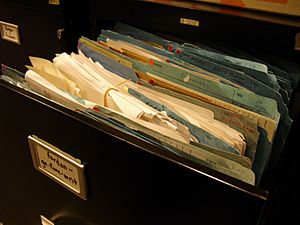Dictionary of Old English facts for kids
The Dictionary of Old English (often called the DOE) is a special dictionary. It focuses on the Old English language. This is the form of English spoken many hundreds of years ago. The dictionary is created by experts at the Centre for Medieval Studies at the University of Toronto.
This huge project helps us understand how English has changed over time. It works alongside other big dictionaries. These include the Oxford English Dictionary for modern English. It also works with the Middle English Dictionary for English from the Middle Ages.
The DOE is still being made today. It covers words from the Old English alphabet. As of 2018, words starting with letters A through I (and K) have been published. The team is now working on words that start with L.
This dictionary uses a lot of computer technology. It is built using a huge collection of texts. This collection includes almost every known surviving text written in Old English.
Contents
What is the DOE?
The Dictionary of Old English is a very detailed dictionary. It helps people study the language of ancient England. It shows how words were used long ago. This helps us understand old stories and poems.
Why is it important?
Learning about Old English helps us see where our modern language comes from. Many of our words have roots in Old English. The DOE is like a time machine for words. It helps scholars and students explore the past.
How the DOE Started
The idea for the DOE began in 1968. Before this, there was an older dictionary called the Anglo-Saxon Dictionary. But it was made a long time ago. People realized they could do a better job with new methods.
The creators of the DOE wanted to use computers. They also wanted to base the dictionary on all known Old English texts. This was a new and exciting idea for a dictionary. A plan for the dictionary was shared in 1973.
Building the Dictionary
Work on the dictionary was expected to start in 1976. However, the first part of the dictionary took longer. It was finally published in 1986. This first part covered words starting with the letter D.
By 2008, the dictionary had reached words starting with G. As of 2015, eight letters (A-H) were finished. This meant over 60% of the dictionary was written. The letter I was released in September 2018.
How to Find the DOE
You can find the Dictionary of Old English in different ways.
Online Access
- Dictionary of Old English: A to I online
* This website lets you search some words for free. * You might need to pay for more searches. * You will need to sign up to use it.
Other Formats
- Dictionary of Old English: A to H on CD-ROM
- Dictionary of Old English: A to G on microfiche
The Word Collection
The huge collection of Old English texts (called the corpus) is also available:
- Dictionary of Old English Web Corpus
- Dictionary of Old English in Electronic Form
An older computer version of the text collection can be downloaded. It is free for schools and researchers. You can ask for it from the University of Oxford Text Archive:
- Dictionary of Old English Corpus in Electronic Form (DOEC)




